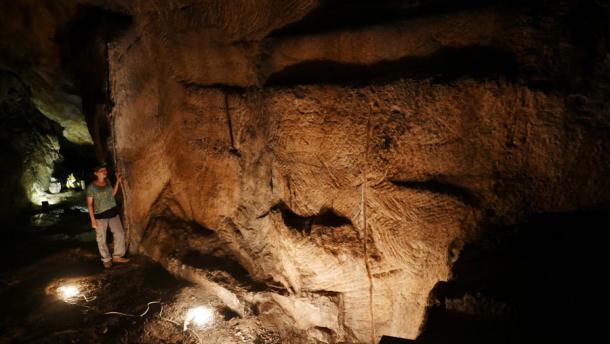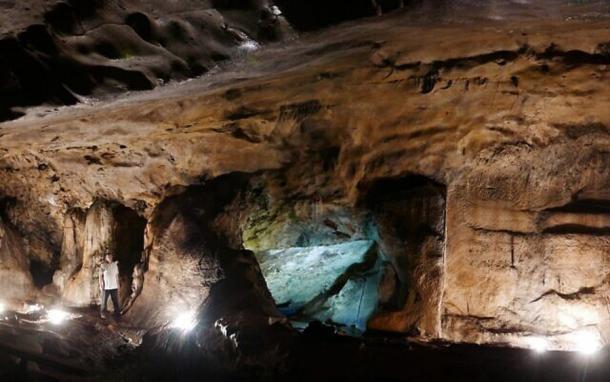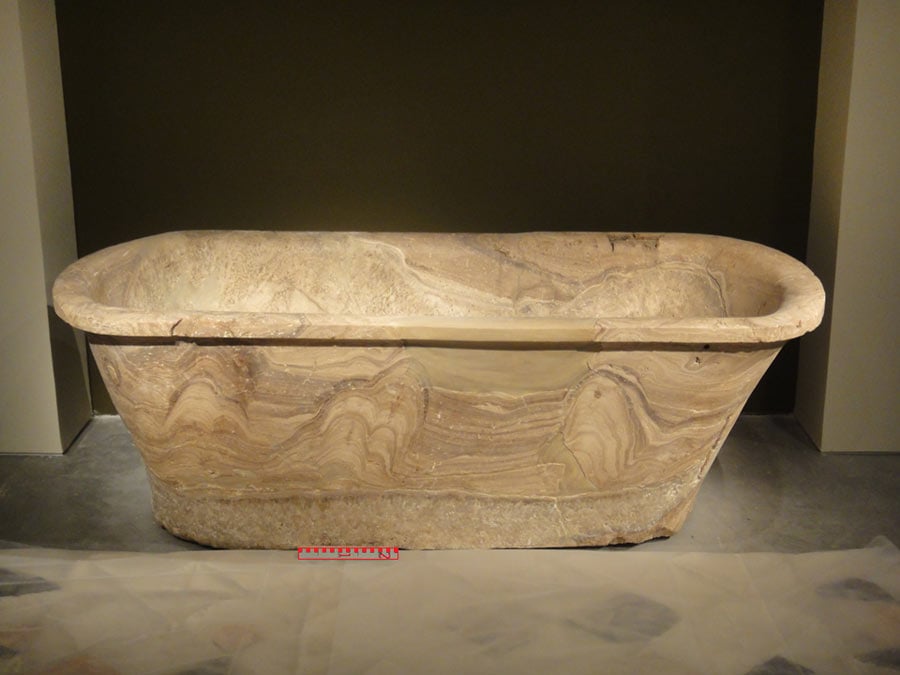Herod the Great’s Alabaster Bathtubs
Herod the Great was renowned for his ambitious projects and extravagant tastes. Now a major discovery has come regarding these projects, from of all places, his bathtub. Two beautiful bathtubs constructed for Herod the Great, the Roman client king who ruled the province of Judea in the first century BC, were made from high-quality stone that was quarried in Israel,
This paradigm-changing conclusion has been revealed in a new study appearing in the journal Scientific Reports. It emerged from the work of a team of archaeologists and chemists associated with various universities in Israel. Using the most up-to-date tools of chemical analysis, they were able to match the chemical signature of the fine alabaster used to make the bathtubs with alabaster found in a quarry near Jerusalem, a quarry that was in use during the time when Herod ruled the region.
At first consideration, this may not seem like such a significant discovery. But it is, because before this research was completed it had long been assumed that all the high-quality alabaster used in the ancient Kingdom of Judea had been imported from Egypt. Now that they know this isn’t true, scholars will be forced to re-evaluate what they’d previously believed about construction practices in ancient Israel, specifically among elites.
- Herod the Great: A Biblical Tyrant But An Able Protector of Judaea
- Extremely Rare Alabaster Statue of Queen Tiye Found in Egyptian Funerary Temple
There was Alabaster in Ancient Judea After All
Herod the Great was known for his luxurious tastes. His preference for the finer things in life was reflected in many ways, as archaeologists discovered a few years ago when they excavated two grand and exquisitely designed alabaster bathtubs from two Herodian palaces in Israel. One of these huge tubs was installed in his Kypros fortress near Jericho, and the other in his showplace palace of Herodium just south of Jerusalem.
Alabaster is a malleable mineral that can be used to make many types of architectural or sculpted objects, including some of very high quality. The mineral is soft enough to be precisely carved down to the smallest detail, and that has made it attractive as a construction or manufacturing material for thousands of years.
Nature provides two different bases for alabaster, one being calcite and the other gypsum. Calcite-alabaster is superior in its appearance and structural stability, and it was the preferred material of Herod the Great and other wealthy individuals in Roman-era Judea (modern-day southern Israel).
This latter fact has long been known, but up until just recently no source of calcite-alabaster had ever been found in Israel. Calcite-alabaster quarries were common in Egypt in the first millennium BC, however, and that had led scholars to conclude that any ancient calcite-alabaster structures or artifacts found during excavations in the southern Levant (Israel and Palestine) were likely made from stone imported from Northeast Africa.
But this theory was suddenly thrown into doubt not long ago, when archaeologists discovered an ancient calcite-alabaster quarry near Te’omim cave, which is located in the hills of Jerusalem near the Israeli city of Beit Shemesh. This quarry was first of its kind ever found on Israeli soil, and researchers found evidence showing that rock had been excavated there as early as 1500 BC.
- Wyoming Declared Oldest Mine in Americas: Red Ochre Mined there 13,000 Years Ago!
- Vast Roman-Period Emerald Mines Revealed in Egyptian Desert

Ayala Amir in Israel's Te'omim Cave beside the wall of the quarry. Signs of quarrying-scars and cessation of quarrying are visible on the quarry’s walls and floor (Prof. Boaz Zissu, Bar-Ilan University/ Nature)
Clearly, this discovery meant that the calcite-alabaster rock used to build Herod’s bathtubs could have come from local sources. Common sense would suggest he would have chosen a local source for these building materials if one were available, given the added expense associated with long-distance importation—and that common-sense conclusion is now backed by definitive scientific proof, as the authors of the Scientific Reports article explain in detail.
Chemistry Provides the Answers
That exciting proof was discovered thanks to the tireless efforts of Tel Aviv University PhD student and aspiring archaeologist Ayala Amir, who was the lead author of the recently published study. While still enrolled in her master’s degree program at Bar-Ilan University, Amir became determined to solve the mystery of the true source of the calcite-alabaster used to build Herod’s massive 1.65-ton (1.5-metric ton) bathtubs.
“We know that artifacts made in Egypt were imported to Israel and it was thought that the main source for calcite alabaster in Israel was from Egypt,” Amir told the Times of Israel. “In our research study we wanted to check for the first time if these artifacts [the two bathtubs] were actually from Egypt.”
Amir’s father, Dr. Amnon Albeck, is a chemistry professor at Bar-Ilan University, and she knew he possessed the skills and knowledge required to carry out the detailed chemical analysis she wanted to perform. Working together with other experts, the father-daughter pair relied on four types of advanced chemical testing to gain detailed information about the molecular makeup of calcite-alabaster removed from Te’omim, and from ancient Egyptian sources as well.
“All four analytical methods applied in this study gave consistent results, clearly distinguishing the Israeli from the Egyptian calcite-alabaster,” Amir and her co-authors wrote in their paper.
This was the first time an effort to draw a chemical distinction between alabaster taken from different sources had ever been attempted. The success of this procedure allowed for the completion of the next phase of the study, which involved a comparative analysis of the two types of calcite-alabaster with mineral samples taken from Herod’s baths.
“We received two samples from Herod’s bathtubs and they came out in all ways ‘Israeli,'” Amir confirmed, proving that Herod had been quite content to source his alabaster locally.

Israel's Te’omim Cave and the quarry on the right (Ayala Amir, Bar-Ilan University/ Nature)
Chasing an Elusive Quarry
Egyptian alabaster had a reputation as being the best available in the ancient world, and it was natural to assume the status-minded Herod had sourced the construction material for his bathtub from there. But it seems that wasn’t necessary in this instance.
“I think it’s of good quality,” Amir said, referring to the stone quarried at Te’omim. “We haven’t checked too many other vessels, but it seems like high quality, and if Herod the Great used it and it was good enough for him with his luxurious palace then it must have been almost or equally good as the Egyptian alabaster.”
Now that Amir, her father, and their co-authors have pioneered a method for distinguishing alabaster from different sources, they plan to study other alabaster artifacts found in Israel, “to get a bigger and broader picture of the local industry in the ancient times.”
As their research continues, there seems little doubt that the team will discover other artifacts from ancient Judea that were made from locally sourced stone. Once their work is finished they will have a much better idea of how much high-quality alabaster was imported from far-off locations, and how much was “imported” from only a short distance away.
Top image: Herod’s calcite-alabaster bathtub found in Kypros fortress. Source: Prof. Amos Frumkin, The Hebrew University of Jerusalem / Nature
By Nathan Falde



















